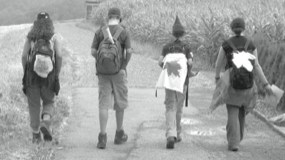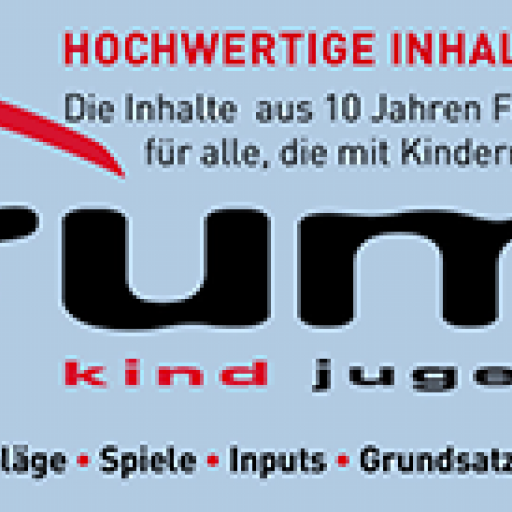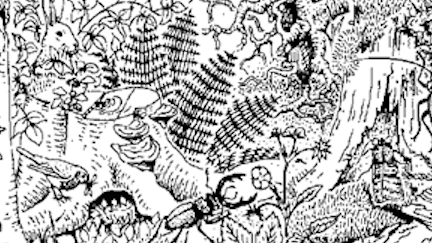A night cross-country game in the forest, abseiling, a trekking camp, an afternoon of raft building and rafting. These activities have been standard in Jungschar work for a long time. Is this now already an experiential education activity? What opportunities and possibilities can offer an experiential education activity?
This article is a Forum booklet article.
Sense and purpose of experiential education
Adventure education* should be understood primarily as a means to achieve set goals and destructive behavior patterns to break - education through the common experience, which should leave a lasting impact. The shared experiences, which often bring psychological and physical borderline experiences with them, imprint themselves lastingly and can be transferred and integrated as empirical values in everyday life.
The four basic elements
Limit situations
In experiential education, physical and psychological limits are learned to know and overcome. When fear is overcome, the person involved learns that they can do more than they think they can. Emotions such as joy and pride can thus be triggered.
Relationship to one's own body
Another basic element is the relationship to one's own body: learning to "feel" oneself better during the sporting activity - recognizing one's own limits - healthy strength testing - activating the body without repressing feelings, conveying high feelings.
Exposure to nature
Nature is the ideal place to conduct experiential education activities. One can learn from nature and its laws, especially when it comes to "survival" (e.g. in nature sports like trekking). Nature offers a counterbalance to consumerism and challenges to preserve this creation.
Social Behaviour
Consideration, solidarity with the weaker, encouraging and strengthening each other, experiencing a sense of community, encouraging each other, learning to endure oneself and others, taking responsibility for others and oneself - are keywords that belong to the fourth element of experiential education activities.
Retransfer to everyday life
Probably the most difficult point is the evaluation/transfer to the everyday life of the child.
The child should learn, for example, that it can manage an exam better if it does not give up so quickly with learning - just as it has previously managed a long hike or trekking.
Another child who has learned to overcome his fear while rappelling or climbing
to overcome it, can learn to approach all the other fears in his life in the same way.
Often this transfer/return to everyday life after experiential education activities is done too superficially or even forgotten. It is very important how leaders of experiential education activities evaluate these experiences with their children and find out together where in everyday life they can also implement and apply the new knowledge.
The transfer back into everyday life is often done too superficially or forgotten
Transfer to everyday life can be done by talking to the whole group or even the individual during or after the activity. If a problem arises in everyday life that can be linked to the experiential education activity, reference can still be made back to the experienced activity months later. The aim of the transfer back to everyday life is that the children receive help through experiential education on how to cope with everyday problems. This transfer is probably the most difficult part of the whole activity, especially when from these insights the child is supposed to gain relevant assistance for coping with difficulties in everyday life.
Pedagogical effect
When children bring little stamina, a low frustration tolerance, low self-esteem and lack of self-confidence, experiential education setting can be a help to break through these behavior patterns or destructive solution strategies. This causes a positive change, which should have a lasting effect.
Experiential education can ...
... show other ways of solving problems.
Instead of directing pent-up aggression against others or oneself, these forces can be put to positive use through sports activities. It is possible, without harming oneself (e.g. with drug use), to experience a high.
... help identify problems. Techniques are developed for these problems, thereby acquiring some self-protection. When the child recognizes a problem (e.g., low frustration tolerance), it can use experiential settings to practice techniques to prevent the undesirable behavior pattern from recurring. It learns to protect itself from thoughtless actions and to set boundaries.
... Encourage creativity and imagination.
In such activities, hidden skills, talents, and resources can be discovered. Also, a new joy in a hobby, such as a sport, can emerge.
... Building relationships through experiences.
Shared experiences and experiences naturally connect and encourage relationship building. Relationship skills can thus be extended to a wider network. The experiential setting helps supportive and stable relationships to live.
... enhance self-worth and self-confidence.
Positive experiences promote self-esteem and boost self-confidence.
Concrete Ideas
- Trekking
- Climbing
- Sailing
- Surfing
- Snowshoeing
- Igloo or snow bivouac
- Indian camp
- Forest, off-road games
- Musical creative projects
- Starting a music band
- Collaborate in an aid project at home or abroad
Experiential education can also be quite a bit broader and not just limited to sports activities. Therefore, musical-creative projects or team sports can also belong to it. However, always only under the aspect of the common experience and the experience resulting from it, which cause the educational effect. The goal is not the end product that results from a project.
Safety aspects
It goes without saying that experiential education activities may only be carried out if enough qualified leaders are present.
A child can be motivated and strengthened in self-worth if he can overcome a limit with the leader, or even better than him. But even if you aim for this effect, it is imperative that enough skilled people are present during the activity.
Linking the Input to the Activity
Conquering Boundaries and Fear as a Christian
Our lives as Christians are always about overcoming fear and boundaries. After an experiential activity, it is therefore very natural to make a link to the Christian faith
Experiential education and input
If the input following the activity addresses the difficulty of the previous experience (e.g. fear, courage, overcoming, boundaries, group cohesion, will, perseverance) this is practically relevant for the audience.
What has just been experienced and endured is now transferred to the spiritual level. In such input, the listener can find himself again, empathize, and he can draw upon his experiences.
Sometimes it can be useful to schedule the input in the middle of the activity:
- When almost everyone on the hike doesn't like it anymore, you can share that Jesus wants to give us strength so that we can persevere as Christians.
- Leaving a person on the zip line, hanging in the middle of the rope, and then talking under the hanging person about how Jesus never leaves us hanging.
- After a woodland game, where the most important thing is to work together as a group, the leader can refer to the body of Christ in the devotion - where everyone is a part and performs the function assigned to them.
As leaders of Christian youth ministries, experiential activities are very valuable and reconnecting back into life as a Christian can be very well taken up in the form of input.
Let's face it, not only do we provide a great activity for our participants, but more importantly, we provide them with guidance and assistance in their faith lives.
- Content and picture: Forum Kind Heft 2/07, page 15 + 16. Experiential education experiences should also have an effect on children in everyday life. For concrete devotional impulses and activity ideas, this article provides. © Copyright www.forum-kind.ch
- Author: Cornelia Gugger, social pedagogue
Experiential education theory according to the concept of the boarding school Grosshaus in Diemtigen BE / Bea Trachsel
Content may be automatically translated. Help improve the quality of the translation with your editing!




